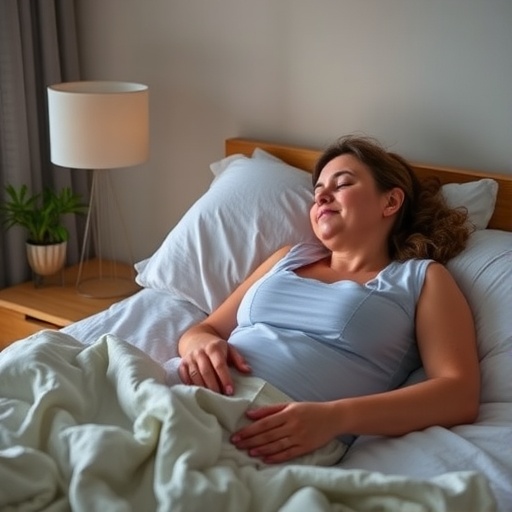In an era where mental health challenges are increasingly recognized as paramount public health concerns, new research sheds light on the complex interplay between physical activity and depression in a distinct subset of individuals known as “weekend catch-up sleepers.” This population, characterized by sleep patterns involving extended rest on weekends to compensate for weekday deprivation, presents unique physiological and psychological profiles that may influence the effectiveness of physical activity as a protective factor against depression. The latest study, drawing from the 2021–2023 National Health and Nutrition Examination Survey (NHANES), reveals a compelling nonlinear relationship between physical activity levels and depression among these individuals, uncovering nuances that could reshape mental health recommendations in the context of erratic sleep routines.
Depression is a pervasive mental health disorder linked to significant morbidity and diminished quality of life worldwide. While the antidepressant effects of physical activity are well-documented, existing research often treats populations as homogenous, overlooking how lifestyle factors such as sleeping habits might modulate this effect. Weekend catch-up sleepers, who engage in rebound sleep on non-working days to offset sleep debt accrued during the week, may experience disrupted circadian rhythms and altered neurochemical pathways, potentially influencing how physical activity impacts their mental health.
Employing data from 1,906 participants in the NHANES database, this investigation utilized sophisticated epidemiological methods, including multivariate linear regression, restricted cubic spline, and two-part linear regression models, to delineate the dose-response dynamics between physical activity quantified in metabolic equivalent tasks (MET)-minutes per week and depression severity assessed via the Patient Health Questionnaire-9 (PHQ-9). These analytic techniques allowed for nuanced detection of nonlinear trends and threshold effects that traditional linear models often mask.
Initial analyses revealed an inverse trend between physical activity and depression scores, corroborating the protective hypothesis that increased physical exertion is associated with fewer depressive symptoms. However, in fully adjusted models accounting for confounding variables such as age, sex, socioeconomic status, and comorbidities, this association narrowly missed conventional statistical significance thresholds. This subtle attenuation prompts consideration of underlying heterogeneity within the study population.
Stratified analyses brought clarity to this ambiguity by uncovering stronger inverse associations specifically among women and middle-aged adults aged 40 to 60 years. In these subgroups, increased physical activity correlated with significantly lower odds of depression, suggesting that biological sex and age-related physiological changes might mediate the mental health benefits of exercise in weekend catch-up sleepers. These findings echo broader literature highlighting differential responses to lifestyle interventions across demographic strata, underscoring the need for tailored public health strategies.
Of particular interest was the identification of a threshold effect in the dose-response relationship. The study found that physical activity levels below approximately 2.48 MET-minutes per 1,000 minutes per week were significantly linked with reductions in depression risk. Intriguingly, beyond this activity level, the association plateaued or even reversed, hinting at a potential nonlinear or biphasic relationship. This phenomenon raises questions about the optimal “dose” of physical activity for mental health gains within populations challenged by irregular sleep patterns.
Such findings challenge conventional “more is better” narratives commonly promoted in physical activity guidelines and suggest that for weekend catch-up sleepers, moderate levels of exercise might confer maximal antidepressant benefits. Excessive physical activity, conversely, may fail to further decrease depressive symptoms or could introduce stressors that negate gains, particularly when combined with disrupted sleep homeostasis. This delicate balance underscores the intricate links between circadian regulation, neuroendocrine function, and mood regulation.
Mechanistic pathways may involve the complex interactions between sleep architecture, hypothalamic-pituitary-adrenal (HPA) axis modulation, inflammatory markers, and neuroplasticity. In weekend catch-up sleepers, irregular sleep could potentiate stress responses and alter neurotransmitter systems such as serotonin and dopamine, which are themselves influenced by physical activity levels. The nonlinear relationship found could reflect a tipping point where physical activity ameliorates or exacerbates these neurobiological processes depending on intensity and individual susceptibility.
Furthermore, the study’s focus on a nationally representative sample enhances the external validity of findings, offering relevant insights for health policymakers and clinicians striving to optimize mental health interventions in diverse populations with heterogeneous lifestyles. It also calls attention to the critical need for incorporating sleep pattern assessments in epidemiological studies examining lifestyle and mental health linkages.
While the observational design limits causal inference, the rigorous statistical adjustments and sensitivity analyses performed provide robust evidence supporting a nuanced interaction between physical activity and depression in the context of weekend catch-up sleep behavior. Future longitudinal and interventional research should investigate whether modifying physical activity intensity and timing can be harnessed therapeutically to mitigate depression risk in sleep-compromised individuals.
This research adds a valuable dimension to our understanding of lifestyle determinants of mental health, emphasizing that recommendations cannot be uniformly applied but must consider individual behavioral rhythms and biological factors. Clinicians might consider evaluating patients’ sleep patterns alongside physical activity habits when devising personalized depression management plans, particularly for middle-aged and female patients who appear most responsive to these interplays.
In summary, this study highlights a complex, nonlinear association between physical activity and depression among weekend catch-up sleepers, identifying a pivotal moderate activity threshold that yields optimal mental health benefits. These insights pave the way for more personalized, rhythm-conscious interventions targeting depression in populations grappling with the dual challenges of sleep irregularity and mood disorders, ultimately striving toward holistic well-being in an increasingly sleep-deprived society.
Subject of Research: The relationship between physical activity levels and depression in individuals with weekend catch-up sleep patterns.
Article Title: The association between physical activity and depression among weekend catch-up sleepers: results from NHANES 2021–2023.
Article References:
Qiu, K., Liu, Y., Zhang, Y. et al. The association between physical activity and depression among weekend catch-up sleepers: results from NHANES 2021–2023. BMC Psychiatry 25, 709 (2025). https://doi.org/10.1186/s12888-025-07095-6
Image Credits: AI Generated




